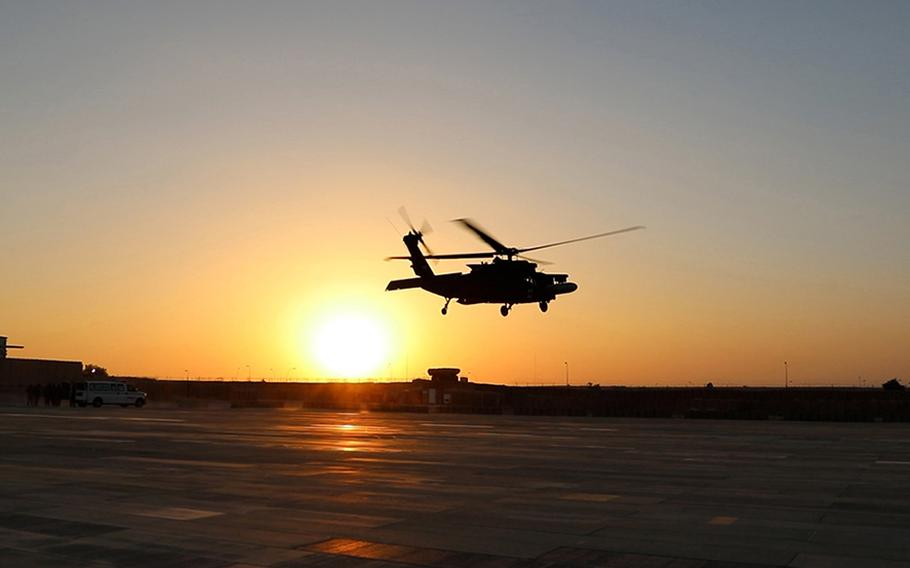
An HH-60M Black Hawk helicopter assigned to the 3rd General Support Avaition Battalion, 126th Aviation Regiment, Massachusetts Army National Guard, prepares to land during medical evacuation training at al Asad Air Base, Iraq, on July 30, 2023. The U.S. and Iraq have a tentative deal to begin the withdrawal of most troops, leaving only a small force to guard against Iranian-backed militias. (Shane Hamann/U.S. Army)
BAGHDAD — The United States will withdraw most troops from Iraq over the next two years but leave a small residual force in the northern Kurdistan region under a plan negotiated by American and Iraqi officials, who disclosed the deal this week.
Defense Minister Thabit al-Abbasi said the two nations had reached an agreement that would transition Operation Inherent Resolve, the U. S-led military mission set up a decade ago to combat Islamic State militants in Iraq and Syria, into a “sustainable security partnership” and would remove the roughly 2,500 U.S. troops now stationed in Iraq in two stages.
“The first phase will begin this year and continue until 2025, while the second phase will conclude in 2026,” Abbasi told al-Arabiya television.
An Iraqi military official, who spoke on the condition of anonymity to describe plans that had not been made public, said a smaller American force was expected to remain in Iraqi Kurdistan, the semiautonomous northern region, to provide a security guarantee for Iraqi Kurds against the Iranian-backed militia groups that hold wide sway in the rest of the country.
For the United States, an ongoing military presence in Kurdistan, where the Pentagon has long operated a low-profile mission near the capital city of Arbil, would also be key to sustaining its operations in neighboring Syria, where some 900 American troops are positioned to prevent the resurgence of the Islamic State.
The government of Syrian President Bashar al-Assad has tolerated the U.S. presence in the eastern part of his country, but the two nations do not have official relations.
The Pentagon and White House did not immediately respond to requests for comment. Maj. Gen. Patrick Ryder, a spokesman for the Defense Department, declined in a news briefing Thursday to confirm whether the plan described by Iraqi officials was accurate from a U.S. perspective.
U.S. officials have long acknowledged the ongoing negotiations that they have said aim to outline an “orderly transition” from the multinational military mission which, at its peak, included thousands of U.S. and allied troops in Iraq and Syria, and supported massive air and ground operations against the Islamic State, also known as ISIS.
Following the culminating battles against the bulk of the ISIS force in 2016 and 2017, in Iraq’s city of Mosul and Syria’s city of Raqqa, the number of U.S. forces has decreased. Today, a much smaller mission headquartered in Baghdad is headed by a two-star officer, Maj. Gen. Kevin Leahy.
Washington and Baghdad have already agreed in principle to end America’s anti-Isis mission in Iraq as part of what President Joe Biden and Iraqi Prime Minister Mohammed Shia al-Sudani described during a visit by the Iraqi leader to Washington this spring as a “natural evolution” as the Islamic State threat abates.
Reuters recently reported the existence of a two-stage plan to withdraw American forces by 2026.
But American troops, while they are no longer involved in regular combat operations as they were in previous years, remain exposed to danger in Iraq and neighboring nations.
Since the eruption of renewed conflict between Israel and Hamas militants in the Gaza Strip last fall, U.S. positions in Iraq, Syria and Jordan have come under renewed rocket, missile and drone attack by Iranian-backed militias in the region. U.S. forces have conducted periodic airstrikes in response, most recently in July.
American troops also continue to conduct periodic operations against remaining ISIS militants in Iraq and Syria. Last month, seven U.S. troops were wounded in an operation against ISIS in western Iraq.
Sudani’s government is eager to demonstrate he can end or at least curtail the American presence, which remains controversial given the sway of militias that are hostile to the United States and America’s history in the country. After President George W. Bush’s invasion of Iraq in 2003, U.S. forces numbered as high as around 170,000 before their withdrawal in 2011. They returned in 2014, as ISIS took over large swaths of the country.
Maintaining a military presence in Iraq would also support larger U.S. security goals in the region. In April, an American air defense battery shot down a ballistic missile near Arbil that was believed to be targeting U.S. ally Israel as part of a massive Iranian attack against the Jewish state.
Iraqi militia groups with ties to Iran have pressured Sudani to conclude an agreement to withdraw U.S. forces, threatening to resume or intensify attacks against foreign troops if they do not depart.
Hussein Allawi, an adviser to Sudani, said there would soon be a joint announcement about the planned withdrawal. “We want the relationship with the United States to return to what it was before 2014,” he said. “The need for the international coalition ended with the defeat of ISIS, and now the Iraqi forces are fully capable of handling the security file efficiently.”
Ryan reported from Washington. Alex Horton and Abigail Hauslohner in Washington contributed to this report.